Reminiscing
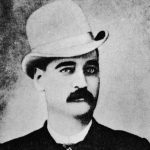 We have long known that my sister, Cheryl Masterson’s family is related to the notorious Bat Masterson…gunfighter, gambler, lawman, and well-known Old West character, but I didn’t really know very much about Bat Masterson. William Barclay “Bat” Masterson was born on November 26, 1853 in Iberville County, Quebec, Canada. His father, Thomas Masterson was born in Canada and by occupation was a farmer. His mother, Catherine McGurk, was an immigrant of Ireland. Bat was the second child in a family of five brothers and two sisters. They were raised on farms in Quebec, New York, and Illinois, until they finally settled near Wichita, Kansas in 1871. During his boyhood years he became an expert in the use of firearms, and accompanied expeditions that went out to hunt buffalo.
We have long known that my sister, Cheryl Masterson’s family is related to the notorious Bat Masterson…gunfighter, gambler, lawman, and well-known Old West character, but I didn’t really know very much about Bat Masterson. William Barclay “Bat” Masterson was born on November 26, 1853 in Iberville County, Quebec, Canada. His father, Thomas Masterson was born in Canada and by occupation was a farmer. His mother, Catherine McGurk, was an immigrant of Ireland. Bat was the second child in a family of five brothers and two sisters. They were raised on farms in Quebec, New York, and Illinois, until they finally settled near Wichita, Kansas in 1871. During his boyhood years he became an expert in the use of firearms, and accompanied expeditions that went out to hunt buffalo.
In the Fall of 1871, when Bat was 18 years old, he and his 19 year old brother, Ed decided to head west to Kansas, looking for adventure by hunting buffalo. During this time, they camped with hunters working along the Salt Fork River in what is present day Comanche and Barber Counties in Kansas. It was during their visits to other buffalo hunting camps that the brothers met several men who would also become legends in western history, including Wyatt Earp, Billy Dixon, Tom Nixon, and “Prairie Dog” Dave Morrow.
Bat Masterson was one of the very few who lived during the lawless days of the Old West who wasn’t there to make a name for himself, or to count the notches on his belt. In reality, he was a genuine and honest man, who didn’t have a reputation for violence, but was loyal to the end, and would defend his friends, if necessary. The nickname “Bat” was given to him by his companions one day while out on one of these hunting trips, the name coming from Baptiste Brown, or “Old Bat,” whose fame as a leader, hunter, and trapper was well known in the generation that preceded Masterson upon the Western stage.
In the summer of 1872, Bat and Ed worked on a construction crew that was expanding the Santa Fe railroad to Colorado. That winter, they returned to buffalo hunting and were joined by their younger brother, Jim in their camp along Kiowa Creek southeast of Dodge City. In January, 1873, the Masterson brothers gave up buffalo hunting. Bat remained in Dodge City, but his brothers returned to the family farm in Sedgwick County, Kansas. Ed, after deciding that farming really wasn’t for him, was soon back in Dodge…just a month later, in fact. Ed went to work in the Alhambra Saloon. For a time, Bat returned to buffalo hunting, but the number of buffalo were becoming fewer and fewer. By 1874, the vast numbers of buffalo roaming Kansas had been slaughtered, so many of the hunters moved south and west into what was hostile Indian Territory.
While this venture would prove profitable, the Indians tribes in the area correctly perceived the post and the buffalo hunting as a major threat to their existence and attacks were being made on some buffalo hunters. The hostile environment didn’t stop Adobe Walls saloon owner, James Hanrahan, from leading a party of Dodge City buffalo hunters, including Bat Masterson, southward on June 5, 1874. Along the way, a band of Cheyenne Indians ran off their cattle stock about 75 miles southwest of Dodge City. The hunters soon joined a wagon train en route to Adobe Walls, arriving just hours before the Indian attack, known as the Second Battle of Adobe Walls, took place.
Early in the morning of June 27, 1874, a combined force of some 700 Comanche, Cheyenne, Kiowa, and Arapaho warriors, led by Comanche Chief Quanah Parker and Isa-tai, attacked the buffalo camp. The 28 men, including Bat Masterson and Billy Dixon, took refuge in the two stores and the saloon. Despite being dramatically outnumbered, the hunters’ superior weapons repelled the Indian assault. After four days of continuous battle, about 100 men arrived to reinforce the post and the Indians soon retreated. Loss numbers vary, but as many as 70 Indians were killed and many others, including Parker, were wounded. The men at Adobe Walls suffered four fatalities.
Of course, the attacks brought retaliation in the form of an expedition against the Indians of the Texas Panhandle in what would become known as the Red River War. Masterson joined the expedition that was order by Colonel Nelson A. Miles, as a civilian scout and a teamster working out of Fort Elliot in what was then called Sweetwater, Texas (now Mobeetie). However, the next spring he was back to buffalo hunting and spending time at his friend Charlie Rath’s store, located about five miles from the fort, which had become the “headquarters” for the buffalo hunters. He was also a frequent visitor to the many saloons in the area. By early 1876, he was working as a faro dealer in Henry Fleming’s Saloon.
On January 24th, he became embroiled in an argument with Sergeant Melvin A. King over a card game and a dance hall beauty named Mollie Brennan. The argument quickly led to a gunplay and King was left dead. However, in the melee, King’s shot passed through Mollie Brennan’s body, killing her, and then hit Masterson in the pelvis. The injury caused Bat to walk with a limp for the rest of his life. After he recovered, Masterson returned to Dodge City, Kansas where he became a lawman along with his friend Wyatt Earp under Ford County Sheriff, Charles Bassett. These were the years that Dodge City was known as a “wicked little town.” Cattle drives had replaced the buffalo hunters as longhorn cattle were driven up from Texas along the western branch of the Chisholm Trail to the railroad. For the next ten years, over 5 million head were driven on the trail into Dodge City.
In July, 1877, Bat was appointed under-sheriff of Ford County under Sheriff Charlie Bassett. That very same month, his brother Ed Masterson became an assistant marshal in Dodge City. Just a few months later, in October, Bat announced in the Dodge City Times that he was a candidate for sheriff of Ford County, stating: “At the earnest request of many citizens of Ford County, I have consented to run for the office of sheriff, at the coming election in this county. While earnestly soliciting the suffrages of the people, I have no pledges to make, as pledges are usually considered, before election, to be mere clap-trap. I desire to say to the voting public that I am no politician and shall make no combinations that would be likely to, in anywise, hamper me in 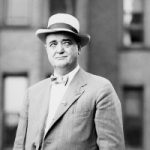 the discharge of the duties of the office, and, should I be elected, will put forth my best efforts to so discharge the duties of the office that those voting for me shall have no occasion to regret having done so. Respectfully, W. B. Masterson.”
the discharge of the duties of the office, and, should I be elected, will put forth my best efforts to so discharge the duties of the office that those voting for me shall have no occasion to regret having done so. Respectfully, W. B. Masterson.”
Masterson never again fought a gun battle in his life after the battle with King, but the story of the Dodge City shootout and his other exploits ensured Masterson’s lasting fame as an icon of the Old West. He spent the next four decades of his life working as sheriff, operating saloons, and eventually trying his hand as a newspaperman in New York City. The old gunfighter finally died of a heart attack in October 1921 at his desk in New York City. He had certainly lived an interesting life.
 Recently, I found out that my family is related to Alvin Cullum York, who was one of the most decorated United States Army soldiers of World War I. York is my 8th cousin once removed on my dad’s side of the family. York received the Medal of Honor for leading an attack on a German machine gun nest, taking 35 machine guns, killing at least 25 enemy soldiers, and capturing 132. York’s Medal of Honor action occurred during the portion of the Meuse-Argonne Offensive in France, which was led by the United States, and was intended to breach the Hindenburg line and force the Germans to surrender.
Recently, I found out that my family is related to Alvin Cullum York, who was one of the most decorated United States Army soldiers of World War I. York is my 8th cousin once removed on my dad’s side of the family. York received the Medal of Honor for leading an attack on a German machine gun nest, taking 35 machine guns, killing at least 25 enemy soldiers, and capturing 132. York’s Medal of Honor action occurred during the portion of the Meuse-Argonne Offensive in France, which was led by the United States, and was intended to breach the Hindenburg line and force the Germans to surrender.
York was born in rural Tennessee on December 13, 1887, the third of eleven children of William and Mary (Brooks) York. His parents farmed, and his father worked as a blacksmith. The York children had minimal schooling because they helped provide for the family, which included hunting, fishing, and hiring out as laborers. After the death of York’s father, he assisted in caring for his younger siblings, and found work as a logger and on construction crews. York wen to church on a regular basis, but he also drank heavily and had a reputation for fistfighting. In 1914 he had a conversion experience, and vowed to improve. He became even more devoted to the Church of Christ in Christian Union.
Upon being drafted into World War I, York initially claimed conscientious objector status on the grounds that his denomination forbade violence. It was because of his internal struggle about whether or not war was the same 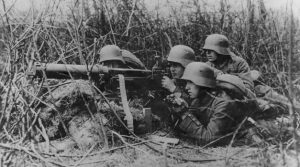 as murder. York prayed about it for the better part of a whole night, before feeling led to proceed with his military assignment. York joined the 82nd Division as an infantry private, and went to France in 1918. He was a part of the group of soldiers know as dough boys. In October 1918, York was promoted to corporal, as one of a group of 17 soldiers assigned to infiltrate German lines and silence a machine gun position. After the American patrol had captured a large group of enemy soldiers, German small arms fire killed six Americans and wounded three. York was the highest ranking of those still able to fight, so he took charge. While his men guarded the prisoners, York attacked the machine gun position, dispatching several German soldiers with his rifle. By the time six Germans charged him with bayonets he was out of rifle ammunition, so he drew his pistol and shot them all. The German officer responsible for the machine gun position had emptied his pistol while firing at York, but missed. This officer then offered to surrender, and York accepted. York and his men marched back to their unit’s command post with more than 130 prisoners. York was immediately promoted to sergeant, and was awarded the Distinguished Service Cross. After further investigation the award was upgraded to the Medal of Honor. York became a national hero and international celebrity. He also received decorations from several foreign countries, including France, Italy, and Montenegro.
as murder. York prayed about it for the better part of a whole night, before feeling led to proceed with his military assignment. York joined the 82nd Division as an infantry private, and went to France in 1918. He was a part of the group of soldiers know as dough boys. In October 1918, York was promoted to corporal, as one of a group of 17 soldiers assigned to infiltrate German lines and silence a machine gun position. After the American patrol had captured a large group of enemy soldiers, German small arms fire killed six Americans and wounded three. York was the highest ranking of those still able to fight, so he took charge. While his men guarded the prisoners, York attacked the machine gun position, dispatching several German soldiers with his rifle. By the time six Germans charged him with bayonets he was out of rifle ammunition, so he drew his pistol and shot them all. The German officer responsible for the machine gun position had emptied his pistol while firing at York, but missed. This officer then offered to surrender, and York accepted. York and his men marched back to their unit’s command post with more than 130 prisoners. York was immediately promoted to sergeant, and was awarded the Distinguished Service Cross. After further investigation the award was upgraded to the Medal of Honor. York became a national hero and international celebrity. He also received decorations from several foreign countries, including France, Italy, and Montenegro.
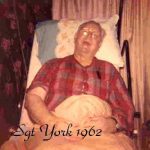
To reward their hero, some businessmen in Tennessee organized the purchase of a farm for York, his new wife, and their growing family. York later formed a charitable foundation to improve educational opportunities for children in rural Tennessee, as a way of giving back o his home state. In the 1930s and 1940s, York worked as a project superintendent for the Civilian Conservation Corps and managed construction of the Byrd Lake reservoir at Cumberland Mountain State Park, after which he served for several years as park superintendent. In his later years, York was confined to bed by health problems. He died in Nashville, Tennessee, on September 2, 1964 and was buried at Wolf River Cemetery in his hometown of Pall Mall.
 My sister-in-law, Jennifer Parmely is a complex woman, who leads a busy life. She is an obstetrics nurse by trade, but that is just her career, albeit a very satisfying one for her. Jennifer knew when she was just 17 years old, that she wanted to be a nurse, and before long, she knew that she wanted to help bring life into the world. She has never changed her mind about that, and has been a nurse at Wyoming Medical Center for about 36 years now. That adds up to a whole lot of babies who can say that Jennifer was there the day they were born. She was the nurse who assisted in the births of all four of my grandchildren. It was very comforting to have her there.
My sister-in-law, Jennifer Parmely is a complex woman, who leads a busy life. She is an obstetrics nurse by trade, but that is just her career, albeit a very satisfying one for her. Jennifer knew when she was just 17 years old, that she wanted to be a nurse, and before long, she knew that she wanted to help bring life into the world. She has never changed her mind about that, and has been a nurse at Wyoming Medical Center for about 36 years now. That adds up to a whole lot of babies who can say that Jennifer was there the day they were born. She was the nurse who assisted in the births of all four of my grandchildren. It was very comforting to have her there.
While nursing is Jennifer’s career, exercise is her passion. She loves all forms of  exercise, both indoor and outdoor. I think that like many of us in the family, she loves to hike. She takes trips to different areas to hike. She has been to New Zealand, Colorado, and today, she and her boyfriend, Bryan are on their way to Arizona to do some hiking there. She hiked a mountain with Bryan a while back in Colorado that was 14,000 feet high. That is an amazing feat for anyone. I have done quite a bit of hiking, but I have never gone to that altitude, so I am curious about how I would do. Jennifer and Brian did very well, but they saw people around them who were having some difficulty breathing deeply. I suppose it all depends on the shape you are in and the lung capacity you have. I don’t know where in Arizona they plan to go hiking, but since I have been in Arizona a number of times and hiked there too, I
exercise, both indoor and outdoor. I think that like many of us in the family, she loves to hike. She takes trips to different areas to hike. She has been to New Zealand, Colorado, and today, she and her boyfriend, Bryan are on their way to Arizona to do some hiking there. She hiked a mountain with Bryan a while back in Colorado that was 14,000 feet high. That is an amazing feat for anyone. I have done quite a bit of hiking, but I have never gone to that altitude, so I am curious about how I would do. Jennifer and Brian did very well, but they saw people around them who were having some difficulty breathing deeply. I suppose it all depends on the shape you are in and the lung capacity you have. I don’t know where in Arizona they plan to go hiking, but since I have been in Arizona a number of times and hiked there too, I 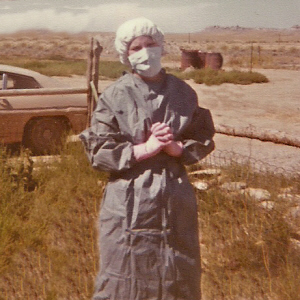 would absolutely recommend the Grand Canyon. We didn’t hike very far in, but the areas we were in were amazing. The next time I go, I want to hike down to the river. I know that wherever they hike, they will have a great time.
would absolutely recommend the Grand Canyon. We didn’t hike very far in, but the areas we were in were amazing. The next time I go, I want to hike down to the river. I know that wherever they hike, they will have a great time.
In many ways, Jennifer’s love of all things healthy has made her not only a nurse helping to bring life into the world, but also a person keeping her own life as strong and healthy as it can be. It’s a great way to live and one that will keep Jennifer, the grandma, in the lives of her three little grandchildren, Reagan, Hattie, and Bowen Parmely, for a long time to come. Today is Jennifer’s birthday. Happy birthday Jennifer!! Have a great day!! We love you!!
 On April 11, 1945, the American Third Army liberated the Buchenwald concentration camp, near Weimar, Germany. Buchenwald was a camp that will be judged second only to Auschwitz in the horrors it imposed on its prisoners, but on this day in 1945, those horrors came to an end. The camp held thousands of prisoners, mostly slave laborers, many of whom were required to work 15 hour days. There were no gas chambers at Buchenwald, but hundreds, and sometimes thousands of prisoners, died every month from disease, malnutrition, beatings, and executions. Doctors performed medical experiments on inmates, testing the effects of viral infections and vaccines. Beginning in 1941, a number of physicians and scientists carried out a varied program of medical experimentation on prisoners at Buchenwald in special barracks in the northern part of the main camp. Medical experiments aimed at testing the efficacy of vaccines and treatments against contagious diseases such as typhus, typhoid, cholera, and diphtheria resulted in hundreds of deaths. The people these doctors were experimenting on were considered, non-human, and so their lives, or the loss thereof, were of little or no consequence to these evil doctors and scientists.
On April 11, 1945, the American Third Army liberated the Buchenwald concentration camp, near Weimar, Germany. Buchenwald was a camp that will be judged second only to Auschwitz in the horrors it imposed on its prisoners, but on this day in 1945, those horrors came to an end. The camp held thousands of prisoners, mostly slave laborers, many of whom were required to work 15 hour days. There were no gas chambers at Buchenwald, but hundreds, and sometimes thousands of prisoners, died every month from disease, malnutrition, beatings, and executions. Doctors performed medical experiments on inmates, testing the effects of viral infections and vaccines. Beginning in 1941, a number of physicians and scientists carried out a varied program of medical experimentation on prisoners at Buchenwald in special barracks in the northern part of the main camp. Medical experiments aimed at testing the efficacy of vaccines and treatments against contagious diseases such as typhus, typhoid, cholera, and diphtheria resulted in hundreds of deaths. The people these doctors were experimenting on were considered, non-human, and so their lives, or the loss thereof, were of little or no consequence to these evil doctors and scientists.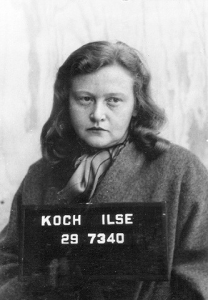
Among the camp’s most gruesome characters was Ilse Koch, wife of the camp commandant, who was infamous for her sadism. Her cruelty and heinous acts earned her the nickname, The Witch of Buchenwald. She often beat prisoners with a riding crop, and collected lampshades, book covers, and gloves made from the skin of camp victims. She was always in attendance when new prisoners were brought in. She required that they be stripped so she could examine their skin. When she found something she liked, the prisoner was killed and their skin removed for her to use. Koch was truly an evil person, and in the end, I think it all came back to haunt her, because after she was tried for a second time and given a life sentence she hanged herself at Aichach women’s prison on September 1, 1967. She was 60 years old. She was said to suffer from delusions and had become convinced that concentration camp survivors would abuse her in her cell. I think her evil ways drove her insane.
As American forces closed in on the Nazi concentration camp at Buchenwald, on April 11, 1945, Gestapo headquarters at Weimar telephoned the camp administration to announce that it was sending explosives to blow up any evidence of the camp…including its inmates. What the Gestapo did not know was that the camp administrators had already fled in fear of the Allies. A prisoner answered the phone and informed headquarters  that explosives would not be needed, as the camp had already been blown up, which, of course, was not true. That act of quick thinking, saved countless lives. The sights the Allied troops saw as they entered the camps must have been sickening. People emaciated due to starvation, the smell of death everywhere, the signs of the horrific experiments that took place there. This place should never have been allowed to exist, and yet here it was. The prisoners who had managed to survive were most likely staring in stunned disbelief, not quite able to believe their eyes. Nevertheless, they had survived and they were liberated. Among those saved by the Americans was Elie Wiesel, who would go on to win the Nobel Peace Prize in 1986.
that explosives would not be needed, as the camp had already been blown up, which, of course, was not true. That act of quick thinking, saved countless lives. The sights the Allied troops saw as they entered the camps must have been sickening. People emaciated due to starvation, the smell of death everywhere, the signs of the horrific experiments that took place there. This place should never have been allowed to exist, and yet here it was. The prisoners who had managed to survive were most likely staring in stunned disbelief, not quite able to believe their eyes. Nevertheless, they had survived and they were liberated. Among those saved by the Americans was Elie Wiesel, who would go on to win the Nobel Peace Prize in 1986.
 With new technology, always comes some risk of failure. Sometimes, the the failure doesn’t hurt anything, but other times, it can be deadly. In the world of submarines, the atomic submarine was the latest thing in the 1960s. The USS Thresher was launched on July 9, 1960, from Portsmouth Naval Yard in New Hampshire. It was built with the latest technology, and was the first submarine assembled as part of a new class that could run more quietly and dive deeper than any that had come before it. The designers and the Navy expected great things from Thresher, and initially, the submarine met their expectations.
With new technology, always comes some risk of failure. Sometimes, the the failure doesn’t hurt anything, but other times, it can be deadly. In the world of submarines, the atomic submarine was the latest thing in the 1960s. The USS Thresher was launched on July 9, 1960, from Portsmouth Naval Yard in New Hampshire. It was built with the latest technology, and was the first submarine assembled as part of a new class that could run more quietly and dive deeper than any that had come before it. The designers and the Navy expected great things from Thresher, and initially, the submarine met their expectations.
Then on April 10, 1963, at just before 8am, the Thresher was conducting drills off the coast of Cape Cod. At 9:13am, the USS Skylark, another ship participating in the drills, received a communication from the Thresher that the sub was experiencing 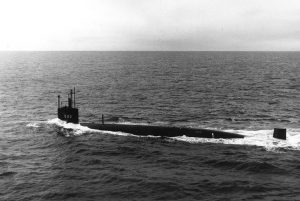 minor problems. Unfortunately, the minor problems turned into a very major problem…almost instantly. Other attempted communications with Thresher failed and, only five minutes later, sonar images showed the Thresher breaking apart as it fell to the bottom of the sea, 300 miles off the coast of New England. Sixteen officers, 96 sailors and 17 civilians were on board. All were killed.
minor problems. Unfortunately, the minor problems turned into a very major problem…almost instantly. Other attempted communications with Thresher failed and, only five minutes later, sonar images showed the Thresher breaking apart as it fell to the bottom of the sea, 300 miles off the coast of New England. Sixteen officers, 96 sailors and 17 civilians were on board. All were killed.
On April 12, President John F. Kennedy ordered that flags across the country be flown at half-staff to commemorate the lives lost in this disaster. A subsequent investigation revealed that a leak in a silver-brazed joint in the engine room had caused a short circuit in critical electrical systems. The problems quickly spread, making the equipment needed to bring the Thresher to the surface inoperable. The submarine went into a freefall to the bottom. There was no time to do anything to stop it or find a way of escape…if one existed.

The disaster forced improvements in the design and quality control of submarines. Twenty-five years later, in 1988, Vice Admiral Bruce Demars, the Navy’s chief submarine officer, said “The loss of Thresher initiated fundamental changes in the way we do business–changes in design, construction, inspections, safety checks, tests, and more. We have not forgotten the lessons learned. It’s a much safer submarine force today.” I don’t think there was necessarily anything that was done so wrong that it could have prevented what happened, but I could be wrong. Obviously, there is always room for improvement in any design, but unfortunately, sometimes the only way to know that an improvement is needed, is to have a disaster strike.
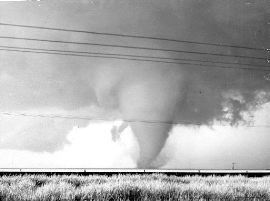 When I think of Tornado Alley, Oklahoma is always among the states that come to mind, but I didn’t know which tornado would be considered the worst one in the states history. Nor did I know that the 1947 Woodward Tornado would continue to hold that status year after year. The most deadly tornado to ever strike within the borders of the state of Oklahoma occurred on Wednesday, April 9, 1947 in the city of Woodward, and across Texas and Kansas. The Woodward tornadic storm actually began in the Texas Panhandle that afternoon, and produced at least six tornadoes along a 220 mile path that stretched from White Deer, Texas, northeast of Amarillo, to Saint Leo, Kansas, west of Wichita.
When I think of Tornado Alley, Oklahoma is always among the states that come to mind, but I didn’t know which tornado would be considered the worst one in the states history. Nor did I know that the 1947 Woodward Tornado would continue to hold that status year after year. The most deadly tornado to ever strike within the borders of the state of Oklahoma occurred on Wednesday, April 9, 1947 in the city of Woodward, and across Texas and Kansas. The Woodward tornadic storm actually began in the Texas Panhandle that afternoon, and produced at least six tornadoes along a 220 mile path that stretched from White Deer, Texas, northeast of Amarillo, to Saint Leo, Kansas, west of Wichita.
The town of Woodward, Oklahoma was hit head on, and was nearly wiped off the map by the powerful tornado. More than 100 people died in Woodward, and 80 more lost their lives 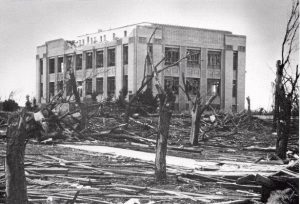 elsewhere in the series of twisters that hit the heartland of the United States that day. The tornado that struck Woodward actually began near Canadian, Texas. It moved northeast, continuously on the ground for about 100 miles, ending in Woods County, Oklahoma, west of Alva. The tornado was massive, measuring up to 1.8 miles wide, and moved along its path at speeds of about 50 miles per hour. It first struck Glazier and Higgins in the Texas Panhandle, bringing devastation to both towns and killing at least 69 people in Texas before crossing into Oklahoma. In Ellis County, Oklahoma, the tornado did not strike any towns, passing to the southeast of Shattuck, Gage, and Fargo. Nevertheless, while no towns were struck, 60 farms and ranches were destroyed and 8 people were killed and 42 injured. In Woodward County, one death was reported near Tangier.
elsewhere in the series of twisters that hit the heartland of the United States that day. The tornado that struck Woodward actually began near Canadian, Texas. It moved northeast, continuously on the ground for about 100 miles, ending in Woods County, Oklahoma, west of Alva. The tornado was massive, measuring up to 1.8 miles wide, and moved along its path at speeds of about 50 miles per hour. It first struck Glazier and Higgins in the Texas Panhandle, bringing devastation to both towns and killing at least 69 people in Texas before crossing into Oklahoma. In Ellis County, Oklahoma, the tornado did not strike any towns, passing to the southeast of Shattuck, Gage, and Fargo. Nevertheless, while no towns were struck, 60 farms and ranches were destroyed and 8 people were killed and 42 injured. In Woodward County, one death was reported near Tangier.
The storm occurred when a cold front from Siberia met a warm and moist stream of air from the Gulf of Mexico, 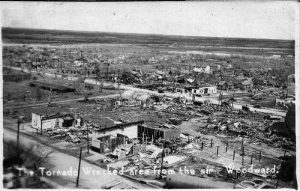 and into Texas. By the time it reached Woodward, some estimated that it was as big as two miles wide. As the storm moved through Woodward, 200 residential blocks were completely leveled and nearly 1,000 homes were razed. Fires broke out in several spots but the heavy rains kept them under control. In all, 107 people were killed in Woodward and many more were injured. The devastating tornado then continued on to Kansas, where significant damage was done but no one was killed. When looting was reported in the areas hit by the tornado, the National Guard was called in to restore order. Army barracks were used to house the homeless until their homes could be rebuilt. Damage caused by this event totaled about $9,700,000.
and into Texas. By the time it reached Woodward, some estimated that it was as big as two miles wide. As the storm moved through Woodward, 200 residential blocks were completely leveled and nearly 1,000 homes were razed. Fires broke out in several spots but the heavy rains kept them under control. In all, 107 people were killed in Woodward and many more were injured. The devastating tornado then continued on to Kansas, where significant damage was done but no one was killed. When looting was reported in the areas hit by the tornado, the National Guard was called in to restore order. Army barracks were used to house the homeless until their homes could be rebuilt. Damage caused by this event totaled about $9,700,000.
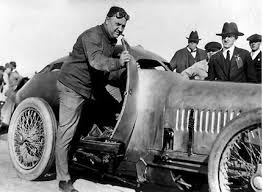 Since there were ways to race, people have been racing. From chariot races to horse races, people soon acquired a taste for speed and for competition. That has never gone away, even though some have paid a dear price for it. When the automobile was invented, it didn’t take long to get to the point of challenges and races. At first, these races took place on he city streets or on highways, but eventually they knew that there had to be a safer way to race.
Since there were ways to race, people have been racing. From chariot races to horse races, people soon acquired a taste for speed and for competition. That has never gone away, even though some have paid a dear price for it. When the automobile was invented, it didn’t take long to get to the point of challenges and races. At first, these races took place on he city streets or on highways, but eventually they knew that there had to be a safer way to race.
The first organized race of the “horseless carriages,” as they were called, was held in France in 1894. The winning speed was less than 10 miles per hour and the winner was disqualified because his steam-driven tractor was deemed not to be a practical vehicle. To me, the whole race was laughable. Ten miles per hour is hardly what I would call a race. The final straw came on April 8, 1916, at the Boulevard Race in Corona, California, when an early racing car driver lost control and careened into a crowd of spectators. The 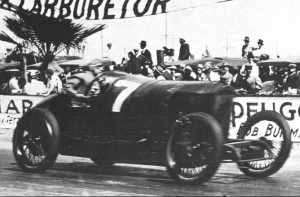 accident killed the driver and two other people. At that time, these racing events were still pretty rare, and this fatal accident encourage organizers to find a better place to hold car races. They came up with the idea of specially built tracks, instead of regular streets.
accident killed the driver and two other people. At that time, these racing events were still pretty rare, and this fatal accident encourage organizers to find a better place to hold car races. They came up with the idea of specially built tracks, instead of regular streets.
While it would seem like things would really get going after that, I wasn’t until twelve years later that the first Grand Prix was held. As time went on and speeds increased, the races became more dangerous. The deadly 1916 Corona Boulevard Race took place on Grand Boulevard in Corona, just east of Los Angeles. “Wild Bob” Burman, had previously set a world speed record for hitting 129 miles per hour. He was driving a blue Peugeot, and leading the race. Burman lost control when a wheel broke and his car crashed through a barrier. Burman died in the accident, along with his ride-along mechanic and a spectator. Five other people in the crowd were seriously injured.
Other racing events that followed, have been even more deadly. When a car crashed into a spectator area at  the 1955 Le Mans, 80 people were killed. Two years later in Italy, 10 spectators were killed at Mille Miglia. I was the last time that race was run. In July 1996, three separate races on the same day claimed victims among the spectators. But, probably the most dangerous of all races has been the off-road Dakar Rally. The best guess is that 47 competitors have been killed in the race’s 27 year history and many more spectators have also lost their lives. The original Dakar Rally ran from Paris to Dakar, Senegal, but fatal accidents in France forced a change in course. The routes have varied since 1999. Modifications have been made over the years to reduce the risk to the public, but drivers remained vulnerable, even to things like the many land mines in North Africa.
the 1955 Le Mans, 80 people were killed. Two years later in Italy, 10 spectators were killed at Mille Miglia. I was the last time that race was run. In July 1996, three separate races on the same day claimed victims among the spectators. But, probably the most dangerous of all races has been the off-road Dakar Rally. The best guess is that 47 competitors have been killed in the race’s 27 year history and many more spectators have also lost their lives. The original Dakar Rally ran from Paris to Dakar, Senegal, but fatal accidents in France forced a change in course. The routes have varied since 1999. Modifications have been made over the years to reduce the risk to the public, but drivers remained vulnerable, even to things like the many land mines in North Africa.

 My niece, Chantel Balcerzak is a very talented artist, and wedding planner. In the last three years she has planned the weddings of her two step-children, as well as her two children’s weddings. I don’t know about you, but for weddings in three years wold probably put me in the nut house, but Chantel seems to take most things in stride. Wedding planning really is her passion, and the weddings of her for kids are her greatest wedding accomplishments…and her greatest responsibilities. She has taken them very seriously, wanting every detail to be perfect.
My niece, Chantel Balcerzak is a very talented artist, and wedding planner. In the last three years she has planned the weddings of her two step-children, as well as her two children’s weddings. I don’t know about you, but for weddings in three years wold probably put me in the nut house, but Chantel seems to take most things in stride. Wedding planning really is her passion, and the weddings of her for kids are her greatest wedding accomplishments…and her greatest responsibilities. She has taken them very seriously, wanting every detail to be perfect.
Chantel decided after planning a couple of these weddings, that she had a knack for it and so, she started a business called Next To The Dress. The business is doing well, but planning a wedding for a customer and planning a wedding for your child are two different things. When it is your child’s wedding, you also have all the  stressed out emotions of your children, as well as your own emotions too. In addition to that, when it is her child’s wedding, Chantel has parts of the planning that normally aren’t a part of the wedding planner’s duties. Being the wedding planner and the mom is a unique role for any wedding planner, and yet being the mom is often how wedding planners come to be wedding planners. They plan a wedding for their child, and then start a business.
stressed out emotions of your children, as well as your own emotions too. In addition to that, when it is her child’s wedding, Chantel has parts of the planning that normally aren’t a part of the wedding planner’s duties. Being the wedding planner and the mom is a unique role for any wedding planner, and yet being the mom is often how wedding planners come to be wedding planners. They plan a wedding for their child, and then start a business.
Chantel is such a great artist, and she brings all of her artistic abilities to create the wedding of her client’s dreams. She can create just about any design her client can dream up. That kind of talent isn’t easy to find, and it takes a lot of effort on Chantel’s part. She spend hours searching the internet for design examples to show her clients, so that their wedding will become the dream they have always fantasized about. That is really what makes Chantel such a great wedding planner. It is more than just an attention to detail, it is a dedication to the dreams of her clients, and isn’t that what it is all about?


While Chantel is very busy right now, she is very excited for this wedding. It is the last for her children, and that can be a little emotional. Chantel is a sentimental person,so crying at weddings is simply a given. I don’t think any mom can go to the wedding of her child and not be emotional. After all, that bride or groom is the baby she carried for nine months, and then raised to adulthood. They will always be her babies, and as we all know, most mom’s are weepy people when it comes the sentimental things their kids do, like weddings graduations, and parenthood. And Chantel considers herself to be a queen of emotion, so don’t expect anything else. Today is Chantel’s birthday. Happy birthday Chantel!! Have a great day!! We love you!!
 During World War II, many children lost their parents to hunger or bombings. Many of the orphanages were either overcrowded or non-existent. To save them from starvation, many Russian military units adopted the orphans. I’m not sure what the units did with the children while they were fighting, but my guess is that some of them wrote home to their wives and told them that they wanted to adopt these little cuties.
During World War II, many children lost their parents to hunger or bombings. Many of the orphanages were either overcrowded or non-existent. To save them from starvation, many Russian military units adopted the orphans. I’m not sure what the units did with the children while they were fighting, but my guess is that some of them wrote home to their wives and told them that they wanted to adopt these little cuties.
Two year old Lucy was adopted by Russian sailors of the Baltic Fleet after her parents died during the siege of Leningrad. Of course, she was too young to really remember her parents, and so whoever ended up adopting her would become her parents in her mind. Little is known about what happened to Lucy after this picture was taken, but if she is still alive, she would be in her mid-seventies now.
Of course, not all children were as blessed to find homes. One orphaned boy who had to live in a foster home wrote in a small notebook about how many of his friends were dying of hunger, and at the same time he drew “amazing” images of food such as “ham and chicken” in the pages of his diary. I guess he was trying to remind himself about the good old days…when food was abundant and his parents were still alive.
People who were living in Leningrad during the siege went through the worst of times. In all, the siege lasted 900 days (almost 2½ years). Food was scarce, and the people withered away. They could not escape and they could not bring in supplies. Eventually, people began to die. In all, more than a million civilians died during those horrible days. Lucy’s parents were among those who didn’t make it, probably because they gave what 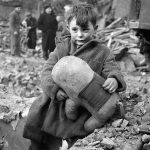 little food they had to her. I can’t imagine what must have gone through their minds. They must have agonized over the instinct to do whatever it took to keep their child alive, and wondering what would happen to her if they died and left her orphaned.
little food they had to her. I can’t imagine what must have gone through their minds. They must have agonized over the instinct to do whatever it took to keep their child alive, and wondering what would happen to her if they died and left her orphaned.
I wish there was a way to find out what happened to Lucy. I hope she had a good life with loving parents, who gave her the kind of life her own parents would have given her, had they lived. I hope she grew up to have a husband and children of her own. And I hope that her adoptive parents told her about the parents who loved her so much that they allowed themselves to starve to death, that she might live. Such a sacrifice should not go unnoticed, nor should it ever be forgotten.
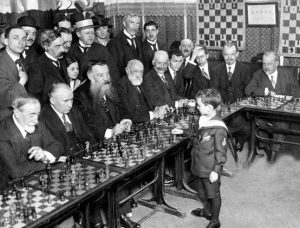 Mastery knows no age. Genius can occur in anyone, and of course, always presents itself when a child is very young. In 1920, one such genius, Samuel Reshevsky was busy mastering chess masters in France. Reshevsky learned chess when he was just 4 years old. He became known as a child chess prodigy and was playing simultaneous games of chess against adults when he was 6 years of age. At age 8 he was playing chess against strong players. Following the events of World War 1, Reshevsky immigrated to the United States. As a 9 year old, his first American simultaneous exhibition was with 20 officers and cadets at the Military Academy at West Point. He won 19 games and drew one. He toured the country and played over 1,500 games as a 9 year old in simultaneous exhibitions and only lost 8 games. In his early years he did not go to school and his parents ended up in Manhattan Children’s Court on charges of improper guardianship. In reality, little Samuel probably could have taught the teachers, so missing some of his education was not detrimental to him in any way.
Mastery knows no age. Genius can occur in anyone, and of course, always presents itself when a child is very young. In 1920, one such genius, Samuel Reshevsky was busy mastering chess masters in France. Reshevsky learned chess when he was just 4 years old. He became known as a child chess prodigy and was playing simultaneous games of chess against adults when he was 6 years of age. At age 8 he was playing chess against strong players. Following the events of World War 1, Reshevsky immigrated to the United States. As a 9 year old, his first American simultaneous exhibition was with 20 officers and cadets at the Military Academy at West Point. He won 19 games and drew one. He toured the country and played over 1,500 games as a 9 year old in simultaneous exhibitions and only lost 8 games. In his early years he did not go to school and his parents ended up in Manhattan Children’s Court on charges of improper guardianship. In reality, little Samuel probably could have taught the teachers, so missing some of his education was not detrimental to him in any way.
Reshevsky was a tough and forceful player who was superb at positional play, but could also play brilliant  tactical chess when warranted. He often used huge amounts of time in the opening, a dangerous tactic which sometimes forced him to play the rest of the game in a very short amount of time. That sometimes unsettled Reshevsky’s opponents, but at other times resulted in blunders on his part. Reshevsky’s inadequate study of the opening and his related tendency to fall into time-pressure may have been the reasons that, despite his great talent, he never became world champion; he himself acknowledged this in his book on chess upsets.
tactical chess when warranted. He often used huge amounts of time in the opening, a dangerous tactic which sometimes forced him to play the rest of the game in a very short amount of time. That sometimes unsettled Reshevsky’s opponents, but at other times resulted in blunders on his part. Reshevsky’s inadequate study of the opening and his related tendency to fall into time-pressure may have been the reasons that, despite his great talent, he never became world champion; he himself acknowledged this in his book on chess upsets.
Reshevsky never became a truly professional chess player. He gave up competitive chess for seven years, from 1924 to 1931, to complete his secondary education. He graduated from the University of Chicago in 1934 with a degree in accounting, and supported himself and his family by working as an accountant. Not everyone could leave off and then pick up their education and never miss a beat. Of course, when you have genius level intelligence, I guess that isn’t a problem.

